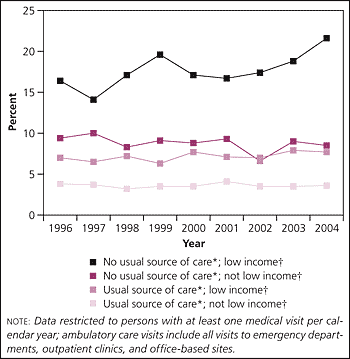
Am Fam Physician. 2009;79(2):94
The recent growth in the use of emergency departments (EDs) is costly, undesirable, and unnecessary. This trend is partly due to a growing proportion of persons who lack a usual source of care. This group is increasingly likely to rely on EDs for their health care needs compared with those who have a usual source of care.
Between 1995 and 2005, the number of visits to EDs increased 20 percent, from 96.5 to 115.3 million visits.1 A 2007 report stated that this trend compromises the quality of care in EDs.2 Greater reliance on EDs is costly and contributes to uncompensated hospital care and ED closures. Most visits are avoidable with appropriate primary care. Difficulty in accessing primary care, especially for persons who are poor and publicly insured, is one explanation for this trend.

Between 1996 and 2004, the number of adults with low incomes (i.e., incomes less than 200 percent of the federal poverty level) reporting no usual source of care increased from 28.0 to 33.1 percent.3 There was a smaller increase, from 19.1 to 21.6 percent, for adults with household incomes greater than 200 percent of the federal poverty level.3 Persons without a usual source of care are generally healthier than those who have one, and are less likely to use any type of health services. However, adults without a usual source of care who have at least one ambulatory care visit in a year are more likely to visit an ED, especially for those with low incomes (see accompanying figure). For adults with low incomes who have no usual source of care, 16.4 percent of all ambulatory care visits in 1996 were to an ED, more than twice the rate of 7 percent for those with a usual source of care. Their ED visit rates rose from 16.4 percent in 1996 to 21.6 percent in 2004.3
Having no usual source of care and relying on EDs for care is associated with worse health outcomes and higher costs. Most developed countries remove barriers to appropriate health care to reduce the health effects of poverty. Providing everyone access to a usual source of care, particularly to a patient-centered medical home, could further improve continuity of care and reduce avoidable ED visits and health care costs.